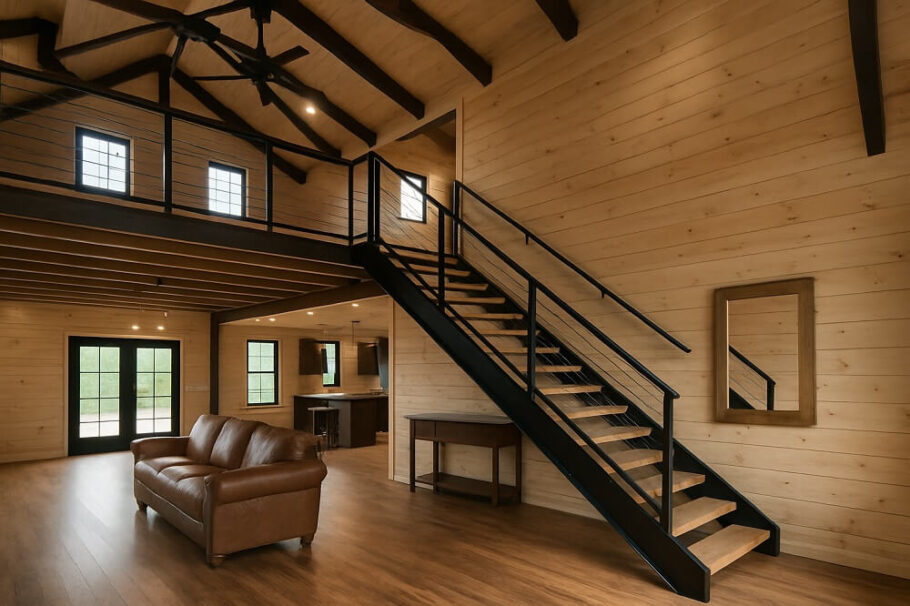When building a barndominium, one of the most overlooked yet critical aspects of the project is the soil beneath the slab. A beautiful design, strong steel frame, and top-notch finishes can all be compromised if the foundation sits on unstable ground. Expansive clay soils and poorly compacted fill are two of the most problematic soil conditions that homeowners and builders encounter. Left unaddressed, they can cause shifting, cracking, and costly structural damage over time.
This article explores the science behind these soil issues, the challenges they pose for barndominium construction, and the practical engineering solutions that can help ensure a safe and long-lasting build.
Understanding Expansive Clay
Expansive clay soils are common in many parts of the United States, particularly in Texas, Oklahoma, and other regions with a history of heavy clay deposits. These soils contain minerals such as smectite and montmorillonite, which absorb and release moisture at high rates. When wet, the soil swells; when dry, it shrinks dramatically. This constant movement, known as soil heave, can wreak havoc on foundations.
- Wet season problem: After heavy rains, clay expands, pushing upward on slabs and piers.
- Dry season problem: During drought or dry months, the clay shrinks, leaving voids under the foundation.
This cycle of expansion and contraction can lead to foundation cracks, misaligned doors and windows, and long-term structural instability.
The Risks of Poorly Compacted Fill
Another common challenge arises when builders use fill dirt to level a lot or raise the elevation of a building site. If this fill is not properly compacted in thin layers, it can settle unevenly over time. A barndominium foundation built on such soil may experience differential settlement, where one part of the structure sinks faster than another. This is especially risky for barndominiums, which often rely on large, clear-span slabs that must remain level for the steel frame to stay square.
Signs of poorly compacted fill problems:
- Cracks radiating across the slab
- Uneven floors
- Doors and windows that don’t open or close properly
- Leaning or warped steel columns
Why These Issues Matter for Barndominiums
Barndominiums, unlike many stick-built homes, often feature large open interiors and clear-span construction. This means the weight distribution is not always evenly spread across the slab. A single pier or corner settling just an inch can create visible misalignment throughout the structure. Since steel framing is rigid and not as forgiving as wood framing, even small movements in the foundation can cause significant structural and cosmetic issues.
Additionally, barndominiums are frequently built in rural areas where land grading and soil compaction may not have been done to strict residential standards. This makes it even more critical for owners and builders to take soil conditions seriously before pouring concrete.
The Role of a Geotechnical Report
The first step in tackling expansive clay or questionable fill is commissioning a geotechnical report. This soil study, performed by engineers, includes:
- Soil borings to evaluate subsurface conditions
- Laboratory testing to determine moisture content, plasticity index, and load-bearing capacity
- Recommendations for site preparation and foundation design
Skipping this step is one of the most common mistakes in barndominium construction. A few hundred dollars spent upfront on a geotechnical report can prevent tens of thousands in repairs down the line.
Foundation Solutions for Expansive Clay
- Over-Excavation and Replacement
In some cases, the top layers of expansive clay are removed and replaced with engineered fill or select non-expansive material such as gravel or crushed stone. This creates a more stable platform for the slab. However, this method is costly and may only be effective if clay is not too deep.
- Moisture Control
Since expansive clay reacts to water, controlling site drainage is key. Techniques include:
- Installing perimeter drains
- Sloping the site away from the barndominium
- Using moisture barriers beneath the slab
- Designing landscaping to avoid concentrated watering near the foundation
- Pier and Beam Foundations
Instead of a monolithic slab, some barndominiums in high-risk areas use a pier-and-beam system. Piers are drilled down to more stable strata below the clay and tied together with grade beams, creating a floating platform less affected by soil swelling and shrinking.
- Post-Tension Slabs
A post-tensioned concrete slab uses steel cables embedded in the slab and tensioned after the concrete cures. This strengthens the slab and allows it to resist the forces of soil movement. It’s a common solution in Texas and other clay-heavy regions.
Solutions for Poorly Compacted Fill
- Proper Compaction During Site Prep
If building on fill, compaction must be performed in lifts (thin layers), each mechanically compacted to engineering standards. Simply dumping fill dirt and leveling it with a dozer is a recipe for disaster.
- Soil Stabilization
Fill material can be stabilized with lime, cement, or fly ash to increase its load-bearing capacity and reduce shrink/swell behavior. This chemical stabilization binds particles together and makes the soil more resistant to movement.
- Deep Foundations
If the fill is too deep or unreliable, drilled piers or helical piles can be used to bypass the fill and transfer loads to more competent soils or bedrock below.
- Geogrids and Reinforcement
Engineers may recommend geogrids or geotextiles to reinforce layers of fill and distribute loads more evenly across the foundation.
Engineering Best Practices
- Don’t Skip Site Investigation: Always perform soil testing before design begins.
- Use an Experienced Foundation Engineer: Barndominiums are unique, and not all residential engineers are familiar with clear-span steel structures.
- Design for Drainage: Keep water away from the building footprint at all costs.
- Allow for Flexibility: Expansion joints in slabs, post-tensioning, and pier supports give the structure a better chance to withstand soil movement.
- Plan Landscaping Wisely: Avoid planting large trees near the foundation, as their roots can draw out moisture and worsen soil shrinkage.
Real-World Cost Considerations
Addressing expansive clay or poor fill during construction may add 5–20% to your foundation budget, depending on the severity of the conditions and the solution chosen. While this can be a significant upfront cost, it is far less than the expense of repairing a failed foundation. Cracked slabs, distorted frames, and structural settlement can quickly exceed six figures in repair bills.
For example:
- Standard slab-on-grade: $6–$9 per square foot
- Post-tension slab: $10–$14 per square foot
- Pier and beam foundation: $20–$30 per square foot
While the more advanced systems cost more initially, they can mean the difference between a stable home and one plagued by chronic movement.
Conclusion: Building Smart from the Ground Up
A barndominium represents a major investment, often combining the dream of rural living with the modern comforts of a custom home. But no matter how well-designed the floor plan or how strong the steel frame, the entire structure is only as good as the soil it rests upon.
Expansive clay and poorly compacted fill present real challenges, but with the right engineering approach—guided by geotechnical analysis, foundation design, and site preparation—these challenges can be overcome. Whether it’s using post-tension slabs, pier foundations, or proper compaction and stabilization, the key is recognizing soil as the foundation of the foundation.
By investing in soil testing, working with knowledgeable engineers, and preparing the site properly, homeowners can build a barndominium that will stand solid for generations, regardless of what lies beneath the surface.

